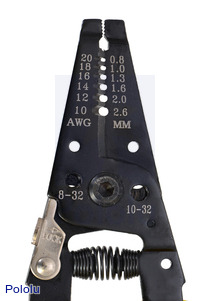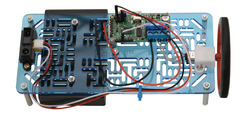Pololu Blog »
Pololu Blog (Page 65)
Welcome to the Pololu Blog, where we provide updates about what we and our customers are doing and thinking about. This blog used to be Pololu president Jan Malášek’s Engage Your Brain blog; you can view just those posts here.
Popular tags: community projects new products raspberry pi arduino more…
New distributor: GarageLab (Doral, FL)
 |
We are happy to welcome GarageLab as a Pololu distributor! GarageLab, located in Doral, FL, is the US branch of our Brazilian distributor Laboratório de Garagem. They carry a wide range of Arduino, microcontroller, and robotics-related products, including their very own Arduino-compatible Garagino.
For distributors in your area, you can check out our complete list of almost 200 distributors.
New products: 10-20 AWG and 20-30 AWG wire strippers
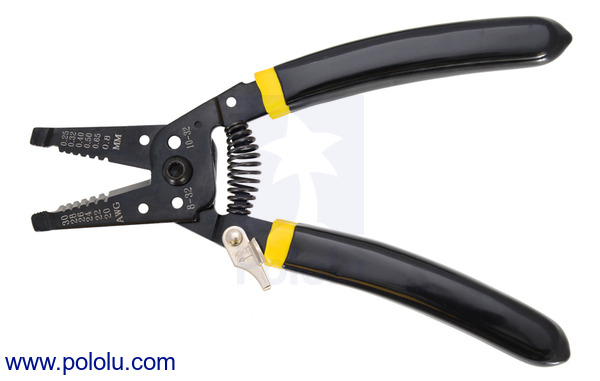 |
Inevitably, if you work with electronics long enough, you will encounter a wire that is too long, too insulated, or too connected (to the wrong thing), and while you might be able to MacGyver your way out of the situation with a pair of scissors or a suitably hardy set of teeth, nothing beats a good wire stripper. With that in mind, we set off in search of some good, basic wire strippers that would get the job done well without breaking the bank. Our favorites were a set of multi-purpose wire strippers and cutters that feature comfortably curved and cushioned grips and a nose that can be used as pliers. One version works with 10 to 20 AWG wires and another works with 20 to 30 AWG wires. (The stripping holes are labeled with the gauge of solid-core wire for which they are intended; for stranded wire, use the next larger hole.)
|
|
MiniTrack three-sided tracked robot
Let’s Make Robots user rhughes posted about MiniTrack, his custom-built tracked robot that features the ability to drive on each of its three sides. It uses our 30T track set and an extra pair of our 42×19mm sprockets. The tracks are driven by a pair of medium power 150:1 micro metal gearmotors, which are controlled by a DRV8833 dual motor driver carrier. MiniTrack also uses two Sharp GP2Y0D805Z0F digital distance sensors for object avoidance:
You can find pictures of various stages of the assembly of this robot and learn what else was involved in making it inside rhughes’s post.
Get a free A-Star 32U4 Micro with orders over $100!
 |
We recently released the A-Star 32U4 Micro, an Arduino-compatible ATmega32U4 breakout board intended to be cheap enough to go into (and stay in) almost any project. To help our customers put A-Stars in everything, we are announcing a new, limited-time offer: on any order over $100, you can get a free A-Star 32U4 Micro with coupon code FREEASTAR.
Taking advantage of this deal? What are you planning to use your A-Star for? Please tell us about your project in the comment section.
Footage from quadcopter at LVBots
This aerial video was filmed at an LVBots meeting on a DJI Phantom 2 quadcopter.
About LVBots
LVBots is a robotics club that has been meeting at the Pololu office in Las Vegas, Nevada for almost ten years. Our meetings are open to all ages and skill levels, and everyone is encouraged to bring their projects to share – even projects that are not capable of flying hundreds of feet into the air. Do you live in the area, or are you passing through? Check out our schedule and join us!
Maker Faire demo: Simple Motor Controller and Sharp analog distance sensor
The Las Vegas Mini Maker Faire 2014 was on April 5th, and as you might have heard, we had a booth there with demos of our products. For more about the faire and a video, see my previous blog post. This post details the Simple Motor Controller and Sharp analog distance sensor demo that we brought. The demo was popular at the faire with both kids and adults, and though it is simple, it is a great tool for showing those who are just getting interested in robotics what one of the first steps to building a robot might look like. Continued…
PID line follower with 5" robot chassis
This PID line follower, originally featured in this Let’s Make Robots post by user Enigmerald, uses our 5" Robot Chassis along with 30:1 MP micro metal gearmotors, extended brackets, and our 42×19 mm wheels. Our QTR-8RC Reflectance Sensor Array is used to sense the line and our TB6612FNG carrier, along with an Arduino-compatible controller, is used to control the motors. A diagram of how everything is connected and the code for the robot are available in Enigmerald’s post. The post also has a link to a basic tutorial on PID tuning using the QTR array.
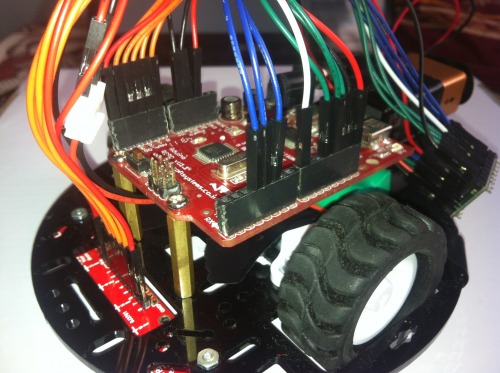 |
New products: Colored miniature tank tracks
 |
We have expanded our selection of miniature tank tracks to include a variety of colors. The new tracks are identical in function to the black miniature track links, but now come in blue, red, and yellow. Track links of different colors can be combined to create fun and interesting patterns to give your robot some added character.
 |
These miniature track links work great for small indoor robots, especially on carpet, and they are compatible with a variety of injection-molded sprocket sets such as:
- 8T Hex for use with Tamiya gearboxes
- 8T Futaba for use with continuous rotation servos with Futaba-compatible servo splines
- 8T GM for use with Solarbotics GM gearmotors and Pololu plastic gearmotors
Free Circuit Cellar magazine April 2014
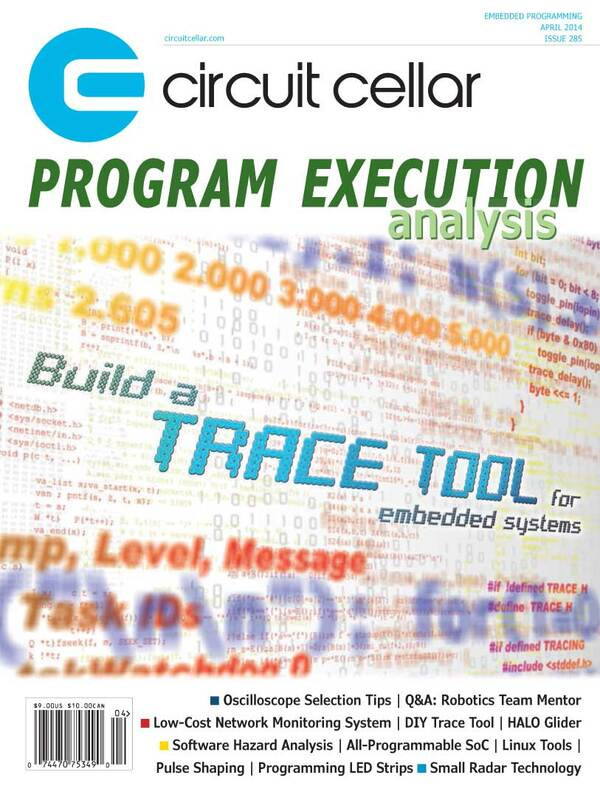 |
Get a FREE copy of Circuit Cellar magazine’s April issue with your order while supplies last. To get your free issue, enter the coupon code CIRCUIT0414 into your shopping cart. The magazine will add 6 ounces to the package weight when calculating your shipping options.
For other issues and more information, see our Free Circuit Cellar Magazine Offers page. All issues are now available for shipping worldwide!
Free Elektor magazine April 2014
Get a FREE copy of Elektor magazine’s April issue with your order while supplies last. To get your free issue, enter the coupon code ELEKTOR0414 into your shopping cart. The magazine will add 7 ounces to the package weight when calculating your shipping options.
For other issues and more information, see our Free Elektor Magazine Offers page. All issues are now available for shipping worldwide!
